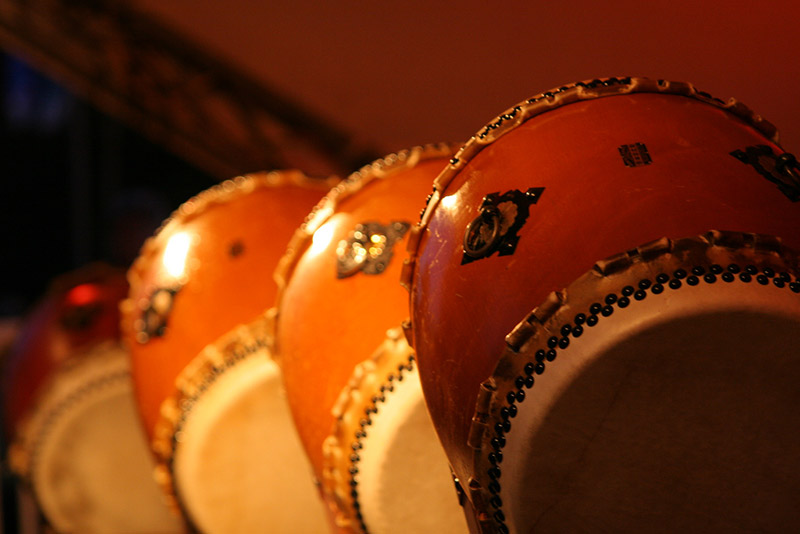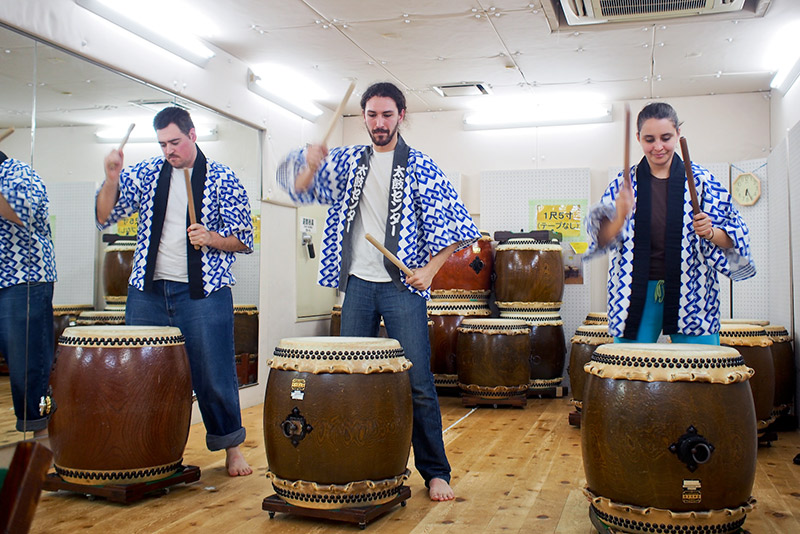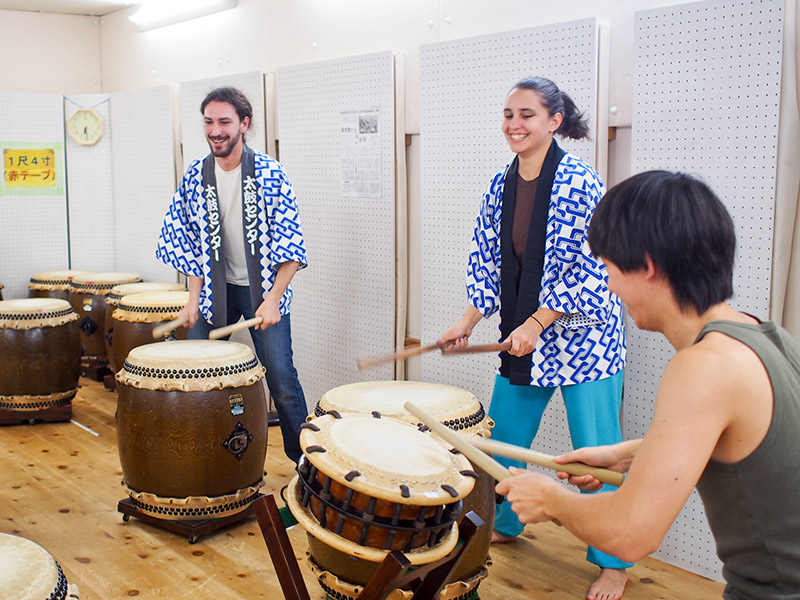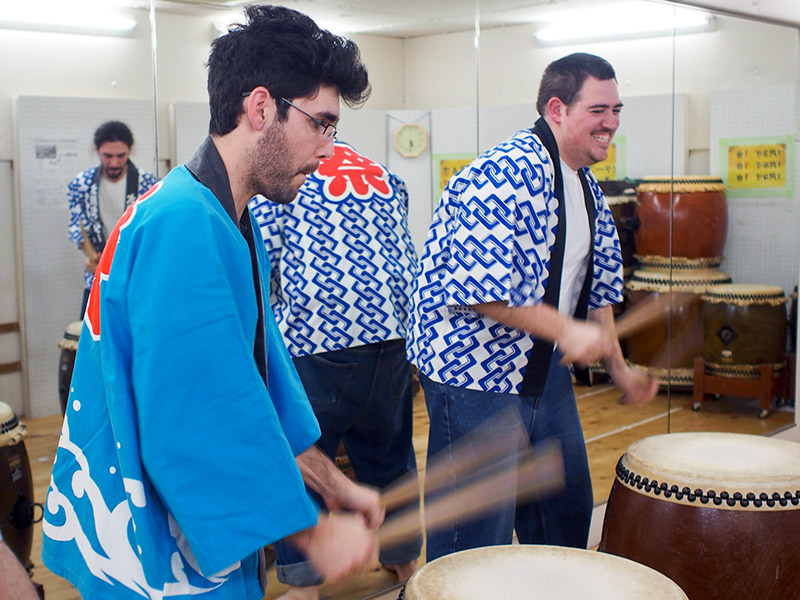Taiko is one of Japan's more successful traditional arts exports. Drums beat in our blood. It's hard not to give in to the rhythm. Besides, taiko just looks fun. Unfortunately, despite lessons being quite popular in Japan, it's almost impossible to find one-off lessons for travelers, which is what makes the Kyoto Taiko Center so special.
The teacher, an exuberant man in his mid-twenties, met my group at the door. The studio looked exactly like the kind where you'd do ballet or Zumba—wood floors and scarcely decorated walls—but part of the floor space was taken up by eight or ten taiko drums on low rolling carts, drumsticks laid neatly on top of each.

Before we began, the instructor had us sit on the floor and led us through introductions, then quizzed us on taiko's age (at least 1500 years), origin (China), the specific name of the drums in the room (wadaiko) and what animal skin the drumhead is traditionally made from. Others around me guessed pig, horse, and cow ("That's almost right," the teacher said; "that's what they're made of these days"), but I went out on a limb and guessed bear. Turns out I was close (if by close you mean I had named a predator of the correct animal): deer.
We did a series of stretches and then picked out our drums. The instructor showed us the intricacies of the stance ("Ground your feet, bend your knees, relax your arms") and had us play a single beat. "Good! But don't hit using the power in your arms. Keep them loose or they'll get tired quickly. Instead, use your knees to bring your bodyweight into the strike." He showed us again and motioned to us to try. We certainly made a valiant effort.

"Now play three strikes, alternating hands." He played it once, then gave us a nod. We played and he corrected our stances. After a few of these, he had us add a kiai at the end of each set of three. "This is a really important part of the performance aspect of taiko," he said. He counted off the beat and we played again—Boom! Boom! Boom! Ha!—and he seemed pleased, twirling his drumsticks to indicate we should go again. By the time we'd played five rounds my arms were getting tired! Clearly my stance needed additional work.
"Now that you know your first sequence, it's time to learn another. This one is called 'Don-Doko-Doko-Don.' I'll show you how it's played." He picked up his drumsticks and hit, saying each syllable of the name with each strike, right hand for the "do" sounds, left hand for the "ko" sounds. It looked easy enough. He counted off for us, and we began. It was right about then that my body decided it no longer had a concept of coordination. Despite knowing perfectly well how to hit, my hands wanted to go in strict "left-right" sequence.

Luckily I wasn't the only one having mysterious coordination problems. The teacher had us try it slower, taking us beat by beat and gradually speeding us up until we were at full speed again.
If I'd thought my arms were tired before, I'd like to tell my past self I was wrong. Now my arms were tired.
"Now that you know Don-Doko-Doko-Don, let's try something a little different. This sequence is called 'Do-Kon-Ko-Doko-Don.'" We stumbled through our first round, our arms facing the same mysterious coordination issue as before, but the teacher powered us through it.
Now it was time to play them back-to-back. He counted off for us, and if I'd thought playing a sequence alone was hard, playing the two of them together seemed impossible. More mystifying, it didn't look that hard—the teacher could literally play with his eyes closed—but for whatever reason when I played I was all elbows. But the teacher was unrelenting. Again and again and again we played the sequence until miraculously our rhythm ironed itself out, and our arms remembered how to listen to our brains.

By this time I'd reached a sort of "drummer's high." I didn't feel the fire in my arms, or the sense of sticky disgust that comes with being drenched in sweat. The exhaustion and high emotions burned through me and hollowed me out, leaving behind the simple exhilaration that comes with hitting stuff with sticks and making a ton of noise.
After a tiny infinity of this, the teacher gave us more "follow me" eyebrows and hit slightly slower but much harder, culminating in one last huge hit that seemed fit to tear a hole in the drumhead, then we all raised our drumsticks and shouted out kiais.
"Great!" the teacher said. Even he was panting and sweating now, his face glowing. "That was amazing, you guys. Now that we've done that, I think we're ready for our last sequence."
We began to play, and although there we had some of the coordination problems we'd faced earlier, they'd mostly evaporated. I was shocked at how well we were all doing with less than an hour's instruction!

"Great job, everyone! Now, before we end class, we're going to have a competition! Split up in to teams!"
We split into two teams and out of nowhere an assistant from downstairs appeared and handed out happi coats to differentiate us. As I put on my happi, I psyched myself up: focus on the rhythm and kick the other team's butt! The teacher had the other team go first. They played well, but there were a couple mistakes in terms of which hand hit when. I knew we could beat them.
My team and I took the floor and began to play. I was in the zone, my mind empty and clear as my hands played the beats. I made a few small mistakes—mostly with hand order—but I got through with almost no problems! My whole team made a valiant effort, but we slipped up a few times, which I was sure would cost us precious bragging rights.
We finished off our turn, and the teacher generously told us that we'd tied, which seemed like a cop out (I mean, my team definitely won). Still, I could see the value in not rubbing in the other team's failures; being beginners, we all needed as much encouragement as we could get.
Now that we were done, the endorphins stopped pumping and we all doubled over, hands on our knees and breathing hard. "Great job!" the teacher said. "You guys worked really hard! You should try taking taiko lessons again when you get home!" We laughed and handed back our happi, but I found myself wondering where the nearest taiko club to my house is.
Header Photo by Vicki Moore
Taiko Center Co., Ltd
Additional Information
113-4 Takatsujiomiyacho, Shimogyo Ward
Kyoto City, Kyoto Prefecture 600-8387
Japan
Taiko Center Co., Ltd's website
+81 075-813-8615
